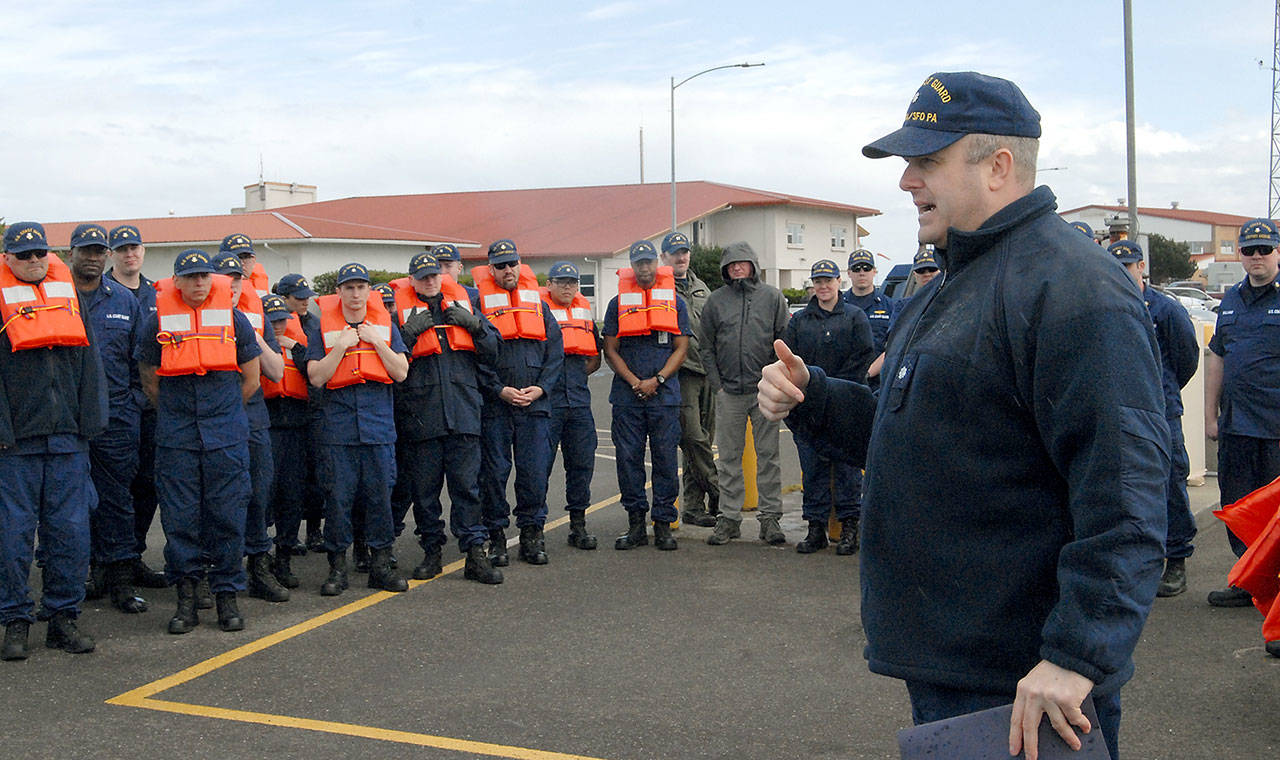PORT ANGELES — Coast Guard personnel stationed on Ediz Hook are ready for the big one.
Crews know they have about 45 minutes after a Cascadia earthquake to evacuate Coast Guard Air Station/Sector Field Office Port Angeles before a 30-foot tsunami sweeps over the base at nearly 10 mph.
“This will pretty much wipe all the buildings off this hook,” Chief Operations Specialist Joel Coffman told crews before an evacuation drill Wednesday.
The 120 personnel stationed at the base — and boat crews that happen to be at port when the magnitude-9.0 earthquake strikes the Cascadia Subduction Zone off the Pacific coast — will board one of two Puget Sound Pilot boats that will carry them to deeper waters in the Strait of Juan de Fuca.
Coast Guard personnel will float above the tsunami waves that will build up in shallow waters and crash into low-lying areas like Ediz Hook and downtown Port Angeles.
“We’ve got to get off, and we’ve got to get off quickly,” Cmdr. Scott Jackson, commanding officer of Air Station/Sector Field Office Port Angeles, told his crews at the foot of the pier.
“This is where you come if something happens and you feel the ground shaking and you’re here on this base.”
Ediz Hook Road/Marine Drive, the only land route to the mainland, will likely be impassable after the Cascadia megaquake.
Emergency management officials predict that the bridge on Marine Drive near the McKinley Mill will collapse.
Jackson said the MH-65 Dolphin rescue helicopters stored in the old hangar may not be flyable.
“We’ve got to get on a boat, and we’ve got to get off as quickly as we can,” Jackson said.
Puget Sound Pilot will launch two boats from the nearby pilot station to evacuate Coast Guard personnel through an agreement. Each pilot boat can carry about 80.
Jackson said it takes about 10 to 15 minutes to launch smaller Coast Guard cutters like the Wahoo and Adelie and longer to launch larger ships like the Active.
Coast Guard rescue boats are ready to launch at a moment’s notice but are too small to carry large numbers of people.
“They crank it up and they’re on their way immediately,” Jackson said before the drill.
“Same thing with the pilot boats.”
Coast Guard crews formed into lines of 10 and marched down the pier to board the arriving pilot boat Wednesday.
The drill commenced at 1:07 p.m. with a “this is drill” announcement on loudspeakers that relayed information about a powerful earthquake on the Cascadia Subduction Zone.
“A tsunami has been generated and is expected to arrive in Port Angeles in 45 minutes,” the announcement said.
Computer modeling from the University of Washington predicts that Ediz Hook will be struck a 10-meter — or 32.8-foot — tsunami wave traveling at about 8 knots — or 9.2 mph — 45 minutes to an hour after the earthquake, Coffman said.
“Another piece of good information: Do not return right away,” Coffman told crews before they boarded the pilot boat.
“Tsunamis do not come in ones. There’s several, and the first one is not always the biggest.”
After a real Cascadia earthquake, Coast Guard personnel would ride out the waves, return to land, report their status, take care of their families and gather at William R. Fairchild International Airport in west Port Angeles.
The Coast Guard has communications equipment and a medical trailer at the airport, where emergency managers will rally after the event.
Clallam County emergency planners recommend preparing for the disaster by keeping three weeks of supplies.
“Do not expect emergency services — fire, police, EMS,” Coffman said.
“They will be immediately overtaxed, and they’re not coming. You need to be self reliant.”
Scientists say the last Cascadia Subduction Zone megaquake and tsunami occurred on Jan. 26, 1700.
“Best estimates by geologists indicate the tsunami has a major event recurrence rate of about 500 years,” Coffman said.
“Currently, we are 319 years into that recurrence cycle, but it’s not an accurate cycle. It could happen at any time.”
________
Reporter Rob Ollikainen can be reached at 360-452-2345, ext. 56450, or at rollikainen@peninsuladailynews.com.

